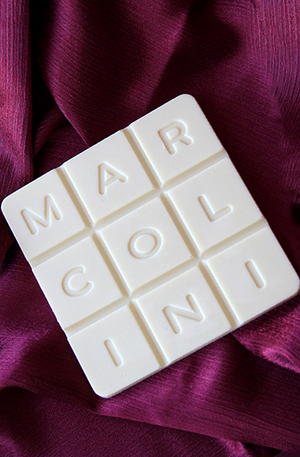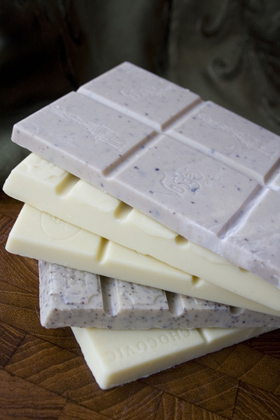 |

| |

Pierre Marcolini’s white chocolate bar wins the beauty competition. Real white chocolate is ivory, never snow white. All photography by Claire Freierman | THE NIBBLE. |
| WHAT IT IS: Twelve of the world’s finest white chocolate bars. |
| WHY IT’S DIFFERENT: More cocoa butter in the recipe, top-quality cocoa butter and a more restrained hand with sugar give these bars aroma and flavor complexities unmatched in lesser white chocolate. |
| WHY WE LOVE IT: For the same reason we like all great chocolate. Nothing else tastes this good! |
| WHERE TO BUY IT: Chocosphere.com and MarcoliniChocolatier.com (for the Pierre Marcolini bar only). |
|
|
 |

The World’s Best White
Chocolate
Page 2: The History Of White Chocolate
This is Page 2 of a five-page review. Click on the black links below to visit other pages.
INDEX OF REVIEW
MORE TO DISCOVER
|
The History Of White Chocolate
Chocolate itself, in bar and candy form, isn’t so old. The first chocolate bar was invented in 1847 by the Fry Brothers in Bristol, England. Prior to then, chocolate was drunk as a beverage. Milk chocolate was first made successfully in 1897, after Daniel Peter, a Swiss chocolate manufacturer, thought to try making it with the powdered milk invented by his neighbor, Henri Nestlé, 30 years earlier. In the intervening years, everyone had been trying to make milk chocolate with milk or cream. (Read the full the history of chocolate.)

Before 2002, the FDA did not allow these bars to be called chocolate, just “confectionary coating.” From
the top, Vosges d’Oliva (with bits of olive), Green & Black’s, El Rey, Café Tasse Café (with ground coffee beans) and Chocovic white chocolate bars.
|
|
For a 20th-century product, the history of white chocolate is shrouded in ambiguity. Some claim it was produced in New Hampshire just after World War I, after an American saw it in Europe. Nestlé launched a white chocolate bar in Europe in the 1930s. According to Nestlé, white chocolate was originally created as a way to use excess cocoa butter (although the company does not specify who created it—a detail perhaps lost in history).
The first mass-distributed white chocolate in the U.S. was Nestlé’s Alpine White chocolate bar, introduced around 1948. It included almonds and had a good run through the 1990s (it is now discontinued, to the chagrin of many fans). Competitor Hershey’s didn’t make Hugs, a.k.a. white chocolate Kisses, until 1993, and has since made white-chocolate versions of Reese’s Cups and Twix.
Today, just about every major chocolate maker produces a bar (usually plain, but sometimes flavored), and many a pastry chef spins white chocolate cake, ice cream and mousse from large blocks of white couverture. Its ivory color makes it a lovely contrast against dark chocolate backgrounds of cakes and bonbons. Certain flavors marry better with white chocolate than they do with dark chocolate—lavender, for example—which leads to new flavor combinations and recipes. |
Over the last few decades, the world has become a more sophisticated marketplace for fine chocolate. In 2002, the FDA amended its standards of identity, enabling white chocolate to be called chocolate if, among other requirements, it is made from a minimum of 20% cocoa butter (by weight), a minimum of 15% milk powder and a maximum of 55% sweetener (generally sugar or maltitol for high-quality sugar-free chocolate). Any other formulation must still be called confectionary or summer coating.
More than a few famous “food experts” do not realize this, and are heard on television shows or read in print misinforming audiences that “white chocolate is not chocolate.” Don’t believe it, no matter how iconic the speaker. We have personally phoned the FDA and, from their lips to this page, white chocolate made under the standards above is chocolate. Or read the FDA standards of identity yourself.
Continue To Page 3: Cacao & Cocoa Butter Content
Go To The Article Index Above
Do you have friends who would enjoy THE NIBBLE?
Click here to send them an invitation to sign up for their own copy. |
© Copyright 2004-2025 Lifestyle Direct, Inc. All rights
reserved. All information contained herein is subject to change at any time
without notice. All details must be directly confirmed with manufacturers, service
establishments and other third parties. This material may not
be reproduced, distributed, transmitted, cached, or otherwise used, except with
the prior written permission of Lifestyle Direct, Inc.
|
 |


|
 |









